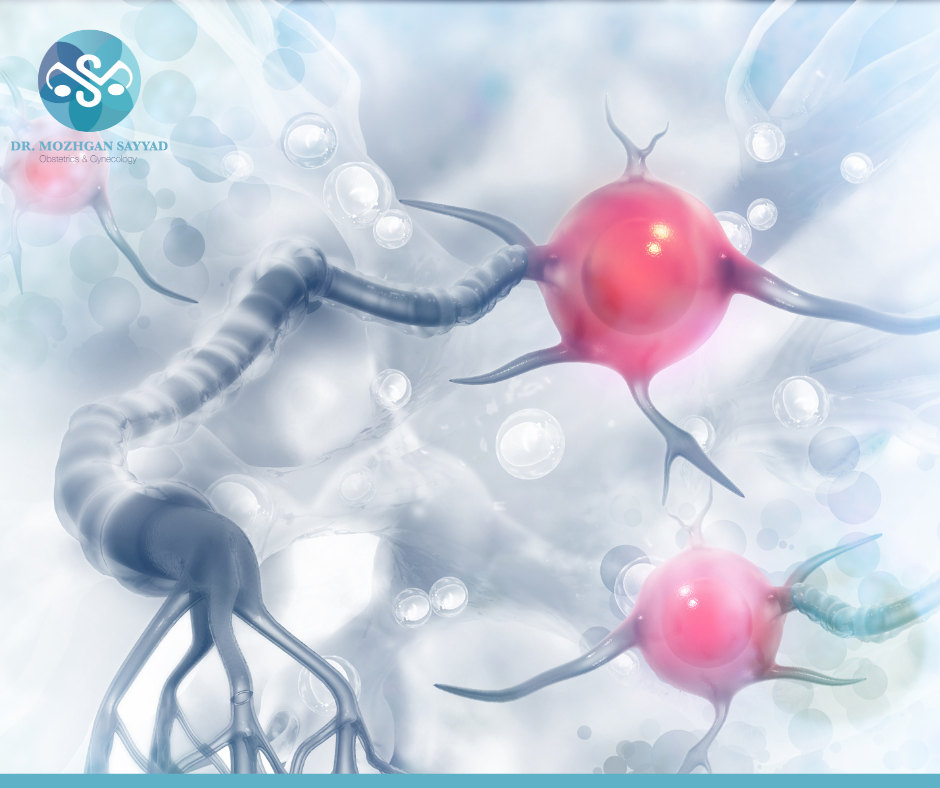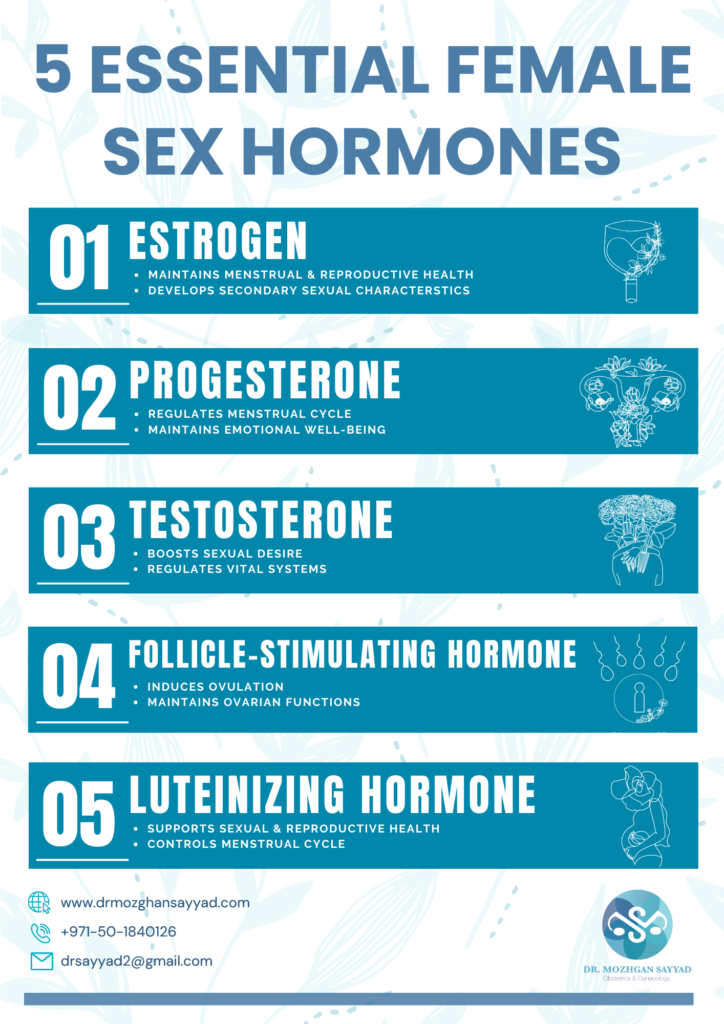Understanding the Importance Hormones in Females
Undoubtedly, hormones are fundamental elements of our life. From fortifying growth and development in the early stages of childhood to regulating our everyday emotions, the importance of hormones cannot be overstated.
In this article, we will look closely at the role of hormones in women’s health, covering everything from their role in promoting hair growth to how they assist in major life transitions.
What are Hormones?
In simple terms, hormones are chemical messengers produced by specialized glands in the endocrine system. As mentioned earlier, they play a vital role in regulating numerous physiological functions in the body.
Some key characteristics of hormones are [i] they are transported through the blood, [ii] they target specific cells with receptors to initiate response, and [iii] they are feedback mechanisms. Everyone has a set of male and female hormones.

Types of Female Hormones
Also known as sex hormones, female hormones are a group of hormones that play a crucial role in the development and regulation of female reproductive system and secondary sexual characteristics. Let’s look at the different types of female hormones and how it impacts women.
- Estrogen
Estrogen is possibly the most obvious sex hormone in females. It is a collective term for a group of hormones, including estradiol, estrone, and estriol, primarily produced in the ovaries and in small amounts by adrenal glands and fat cells. Estrogen levels vary throughout the month; they are highest in the middle of the menstrual cycle and lowest during periods. At menopause, estrogen levels drop significantly. Some of the key functions of estrogen include:
- Developing secondary sexual characteristics [breast development, widening of hips, pubic and underarm hair growth]
- Regulating menstrual cycle
- Maintaining reproductive health
- Maintaining uterine health
- Maintaining bone health
- Maintaining cognitive function
- Maintaining vaginal and sexual health
- Protecting cardiovascular health
- Influencing emotional well-being
- Preserving skin health
- Progesterone
Progesterone is another essential female sex hormone produced primarily by the ovaries and in smaller amounts by the adrenal glands. Progesterone plays a crucial role during the second phase of the cycle by forming a uterus lining for the eggs to be implemented after ovulation. If the pregnancy is successful, progesterone maintains it by stimulating blood to nourish the baby and preparing the breast tissue for milk production. Some of the additional roles of progesterone include:
- Regulating menstrual cycle
- Contributing to breast development
- Developing cervical mucus to protect uterus
- Regulating body temperature
- Reducing inflammation in various tissues, including the uterus
- Maintaining emotional well-being
- Maintaining bone health
- Testosterone
Although it’s generally considered a male sex hormone, testosterone is also present in small amounts in women. In females, it performs the same functions as in men but to a lesser extent. Some of its primary functions are:
- Regulating vital systems [energy levels, mood, reducing inflammation]
- Maintaining body composition and physical performance [body fat distribution, bone density, hair growth]
- Boosting sexual desire
- Follicle-Stimulating Hormone [FSH]
Follicle-stimulating hormone, or FSH, is an essential sex hormone produced by the pituitary gland. Found in both men and women, FSH in females helps control the menstrual cycle and stimulates the growth of eggs in the ovaries. FSH levels vary throughout the month, with its highest levels just before an egg is released, also known as ovulation. Some of the important functions of FSH are:
- Stimulating ovarian follicles
- Producing estradiol, a type of estrogen
- Inducing ovulation
- Regulating menstrual cycle
- Maintaining ovarian functions
- Luteinizing Hormone [LH]
Similar to FSH, luteinizing hormone [LH] is another sex hormone produced by the pituitary gland. The main functions of LH include supporting reproductive and sexual health and controlling the menstrual cycle. LH levels are highest just before ovulation.
Now that we’ve explored the important types of female sex hormones let’s dive deeper into how these hormones work in unison to influence the various aspects of a woman’s life.

Role of Hormones in Stages
Role in Puberty
Puberty is the transitional phase from childhood to adulthood. Although each body is unique, most girls enter puberty between 8 to 13. The production of luteinizing hormone [LH] and follicle-stimulating hormone [FSH] increases during puberty, which in turn triggers the production of estrogen and progesterone. Increased levels of estrogen and progesterone stimulate a wave of secondary sexual characteristics, including:
- Breast development
- Growth of pubic and armpit hair
- Increase in body, especially around hips, butt, and thighs
- Maturation of the ovaries, uterus, and vagina
- The onset of menstrual cycle
- Growth spurt
RELATED: Tackling Puberty: A Guide for Parents | Delayed Puberty in Young Girls
Role in Menstruation
The first menstrual period that begins after breast development is called menarche. Typically, most girls start their period between 12-13 years. To understand the role of sex hormones in menstruation, let’s look at its three phases:
- Follicular Phase: The follicular phase marks the first day of the period. During this phase, the body sheds blood and tissues from the vagina. It is also a time when the estrogen and progesterone levels are at their lowest, which causes irritability and mood swings.
In this period, the pituitary gland also produces FSH and LH, which triggers estrogen levels and stimulates follicle growth in the ovaries. Within each follicle resides an egg, and as the sex hormone levels drop, only one dominant follicle will continue to grow. The steady development of this follicle also triggers endorphins, which leads to improved mood and energy levels.
The follicular phases last about two weeks.
- Ovulatory Phase: The ovulatory phase is when estrogen and LH levels are at their peak. This high level of hormones causes the follicle to burst and release its egg. Fertilization only occurs during this stage, between 12-24 hours after the egg is released.
- Luteal Phase: The final stage of menstruation is the luteal phase. In this phase, the egg travels from the ovary to the uterus through the fallopian tube. Simultaneously, the ruptured follicle releases progesterone, which thickens the uterus lining in preparation for receiving the egg. Once the egg reaches the uterus, it attaches to the uterine wall. If an egg is unfertilized, it leaves the body, marking the end of the current menstrual cycle and the next onset.
Related: Painful Periods
Role in Sexual Desire and Arousal
As mentioned before, estrogen, progesterone, and testosterone play a crucial role in female sexual desire. Higher estrogen levels promote libido, vaginal lubrication, and clitoral sensitivity. Due to regular hormone fluctuations, sexual desire peaks before ovulation.
Related: How to Achieve Great Foreplay | Foods that Boost Libido in Women | Female Sexual Disorder | Female Orgasmic Disorder
Role in Pregnancy
The pregnancy stage begins when successful conception occurs. During this stage, the placenta produces various hormones vital for fortifying pregnancy, including relaxin, human placental lactogen [hPL], human chorionic gonadotropin hormone [hCG], estrogen, and progesterone.
For instance, relaxin supports implantation and growth of the placenta while also preventing contractions from occurring too soon. Whereas the hPL hormone provides the required nutrients for the baby while stimulating milk glands for breastfeeding. As pregnancy comes to an end, the hormone levels return to their pre-pregnancy levels.
Related: Pregnancy Nutrition
Role in Childbirth and Breastfeeding
Female sex hormones, especially estrogen, progesterone, and prolactin, play a crucial role in childbirth and breastfeeding. Let’s understand it further by segmenting the two.
- Role of Sex Hormones in Childbirth
– Estrogen: Responsible for uterine contractions, cervical ripening, and positive feedback for labor.
– Progesterone: Prevents premature contractions.
– Oxytocin: Induces labor by strengthening uterine contractions.
- Role of Sex Hormones in Breastfeeding
– Prolactin: Responsible for milk production and postpartum lactation.
– Oxytocin: Develops milk rejection reflex or letdown.
– Estrogen and Progesterone: Responsible for breast health and duct development.
Role in Perimenopause and Menopause
Perimenopause, also known as menopausal transition, is the phase leading to menopause. It typically begins several years ahead of menopause and lasts until it arrives. During perimenopause, hormone production within the ovaries slows down, leading to irregular menstrual cycles, vaginal dryness, changes in fertility, sleep disturbances, and other physical, emotional, and psychological changes.
On the other hand, menopause marks the end of a woman’s reproductive years. It is when a woman has gone 12 consecutive months without a period. During this period, estrogen and progesterone maintain low levels, which may increase the risk of osteoporosis [thinning bones] and cardiovascular disease.
Related: Menopause Counselling

Role of Hormones in Other Aspects
Apart from its major influence on women’s reproductive health, let’s look at how these sex hormones contribute to other aspects of women.
- Hair: Estrogen is typically considered a ‘hair-friendly’ hormone. It promotes hair growth and thickness by reducing hair loss. As estrogen levels are high during pregnancy, some women grow thick and long hair. However, when estrogen levels are low during perimenopause and menopause, some women may experience hair loss.
- Sweating: Hormone fluctuation, especially a decline in estrogen during perimenopause and menopause, can lead to hot flashes and night sweats.
- Food Cravings: As hormones fluctuate during the menstrual cycle, particularly in the luteal phase, women may have food cravings and appetite shifts.
- Headache: Hormonal variations during the menstrual cycle, especially fluctuations in estrogen and progesterone, can induce headaches or migraines in women.
- Emotions: In some cases, estrogen has mood-regulating properties in women. During the menstrual cycle, an increase in estrogen levels may lead to better mood and increased energy. Contrarily, when estrogen drops, it may lead to mood swings and irritability.
Hormonal Imbalance
As we’ve understood, hormones are always fluctuating. However, long-term imbalances can lead to several symptoms, including:
- Irregular periods
- Excessive face and body hair
- Acne
- Vaginal dryness
- Low libido
- Breast tenderness
- Hot flashes and night sweats
- Mood swings
- Weight changes
- Hair loss or thinning
- Sleep disturbances
- Digestive issues
- Joint pain
- Skin changes
- Changes in blood sugar
- Headaches or migraines
In some cases, hormone imbalance may signify an underlying condition like:
- Polycystic ovary syndrome [PCOS]
- Primary ovarian insufficiency
- Excess body weight
- Excess androgen
- Ovarian cancer
Related: Phenotypes of PCOS

Get Help with Dr. Mozhgan
Speak to your doctor if you experience the following symptoms:
- Morning sickness or other signs of pregnancy
- Decreased sexual desire
- Vaginal dryness or pain during intercourse
- Skipped periods or increasingly irregular cycles
- Difficulty getting pregnant
- Pelvic pain
- Hair loss or growth on the face or trunk
- Depression after giving birth
- Prolonged menopause symptoms that intervene in your life
Without a doubt, hormonal imbalance is a concern that you shouldn’t dismiss. If you’re searching for a leading female gynecologist in Dubai, consider Dr. Mozhgan. She is a trusted medical expert with invaluable experience in women’s health. Dr. Mozhgan is guaranteed to offer necessary evaluations and personalized care to address hormonal imbalances and restore the quality of your life.
FAQs
Q1. Does sex change the hormones in the female body?
Yes, sexual intercourse does have an impact on hormones in women. During arousal and intercourse, the body goes through a series of physiological changes that are influenced by hormones. Some ways sex can change hormones include [i] Increasing Oxytocin, also known as the ‘love hormone’ or ‘bonding hormone’ [ii] Releasing Endorphins, which are natural mood-boosters [iii] Regulating Cortisol, the primary stress hormone [iv] Influencing Menstrual Cycles [v] Maintaining Healthy Levels of Estrogen and Testosterone [vii] Releasing Prolactin, a hormone released after orgasm that has a temporary impact on sexual desire and arousal.


